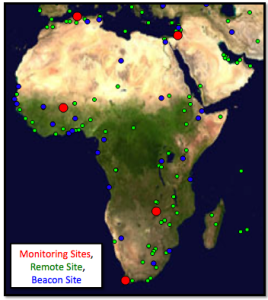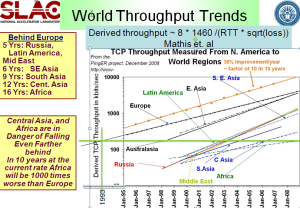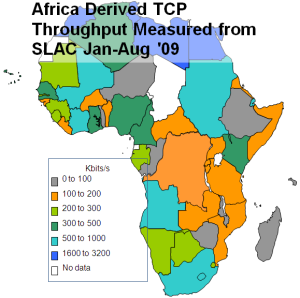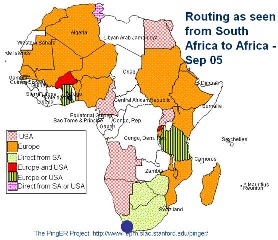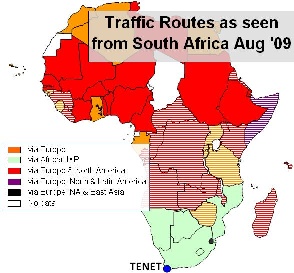...
PingER monitors over 165 sites in 50 African countries, that contain about 99% of Africa's population. The African countries that are not currently monitored are Chad, Comoros, Equatorial Guinea, Sao Tome & Principe and Western Sahara. The results from PingER are used heavily in this study. Below is seen a map of the PingER sites in Africa. The red dots indicate PinGER monitoring sites, the blue are beacon sites that are monitored by most of the over 40 PingER monitoring sites around the world, and the green are other sites monitored by at least one monitoring site.
This study first outlines the new submarine fibres coming into place for E. Africa. It goes on to summarize the current state and trends of Internet performance for Africa and the costs particularly for Sub_Saharan and E. Africa. Following this we discuss the role of the emerging National Research and Education Networks (NRENs) and traffic routing. Then we look at the RTTs of hosts in Kenya and Tanzania on the day following the start of operation of the Seacom cable, the identification of further hosts of interest, followed by the changes in RTTs as hosts later moved their routing from satellite to terrestrial routes.
Submarine Fibre Cables
...
for E. Africa
At the moment the SAT-3/WASC/SAFEfibre has been in place for some time and connects up several countries on the W. Coast of Africa. The Seacom line is not the only fiber-optic cable project on Africa's East coast — others include the Eastern Africa Submarine Cable Systems (EASSY), The East African Marine System (TEAMS)and Lion — but it will be the longest and have highest capacity (1.28 terabytes per second). The EASSY and TEAMS are designed to build out African telecommunications networking, but Seacom is the only line that directly will connect east coast urban areas in Kenya, Madagascar, Mozambique, South Africa and Tanzania to France and India. TEAMS landed in Mombasa early June 2009 and is currently undergoing testing while EASSY and Lion are expected to be operational by mid-2010. Maps of the various fibres is shown below and more details are available here.
...
For the interior backbones (or backhauls) associated with these landing points, see here.
Current State of the
...
African Internet
The throughputs measured to Africa from N. America for the last decade are shown below in the left hand figure. It is seen that not only do African sites lag the rest of the world in throughput, being roughly in the state that European sites were over a decade and a half ago, but also they are falling further behind with time. Further, bear in mind that for Africa, Mediterranean countries and South Africa have the better perfomance and E. Africa is the worst off (see the the left map below). Thus the arrival of a terrestrial submarine fibre cable link to the rest of the world for E. Africa is a very significant development.
...
<ac:structured-macro ac:name="unmigrated-wiki-markup" ac:schema-version="1" ac:macro-id="0d8c4e674808cb77-6491d8cb-48e240a4-93d7b514-1c7441d1c2e4fc8cbbd71334"><ac:plain-text-body><![CDATA[ | Throughput from SLAC to Regions of the World | Derived Throughput from SLAC to Africa Jan-Aug '09 [[xlsx | ^africa-thru-aug09.xlsx]] | MinRTT from SLAC - Aug. 2009 [[xls | ^map-africa-minrtt-aug2009.xls]] | ]]></ac:plain-text-body></ac:structured-macro> |
|---|---|---|---|---|---|---|
|
|
|
...
<ac:structured-macro ac:name="unmigrated-wiki-markup" ac:schema-version="1" ac:macro-id="63ac670ffa7504a1-fde8c2fb-49044299-b41e9005-4df7b2430cece868af826abf"><ac:plain-text-body><![CDATA[ | Routing from South Africa to African Countries (Sep '05) | Routing from South Africa to African Countries (Aug '09) [[xls | ^routing-africa-aug2009.xls]] | Routing from Burkina Faso to African Countries (Aug '09) [[xls | ^routing-africa-aug2009.xls]] | ]]></ac:plain-text-body></ac:structured-macro> |
|---|---|---|---|---|---|---|
| |
|
...
Connections from Burkina Faso in August 2009 were direct to only Senegal, Mali, and Benin (in green). Most other countries in grey were reached by intercontintal connections via Europe, followed by many in teal that go via Europe and N. America. Somalia was reached via Europe, N. and S. America. Burundi was reached via Europe, N. America and E. Asia.
Initial Results on First Day
One would expect with the use of a terrestial fibre rather than a geo-stationary satellite that the minimum RTT woud be reduced from >=400ms to 200-300ms as seen from the US. Also the reduced congestion enabled by the higher speed links should make the average RTT more stable and reduce the packet loss. Below are shown the average RTTs and losses from SLAC on the West Coast of the US to various hosts on the East Coast of Africa. These are all measured using the PingER project's data.
...
To enable easier selection and looking for changes for these East African Coastal countries, we added a PingER affinity group (E.AFRICA_COAST) for hosts monitored in Kenya, Mozambique and Kenya. The minimum RTT should be very sensitive to a change in the route from a geo-stationary satellite to a terrestrial fibre link. An example of selecting data sensitive to the E. African fibre connection can be seen in the table of PingER daily minimum RTT data for the group E.AFRICA_COAST. This data is updated daily.
Adding Extra Hosts
We received suggestions from Don Riley of UMD:
...
Steve Song pointed out that a good PingER point would be the Durban University of Technology. They are the only university in South Africa to be currently connected to Seacom. All the rest are waiting for the development of the national SANREN backbone, later this year. I added www.dut.ac.za to the list of hosts monitored by PingER on 8/6/09. We will look to see whether we can see differences between it and other hosts monitored in South Africa.
Later Results Illustrating Impact of Changes
To assist in the selection of hosts in this region from the pingtable results, we created an affinity group that contains all hosts in Kenya, Mozambique and Tanzania. This makes it much simpler to look at the minimum RTT for just such hosts for the last few days
...
